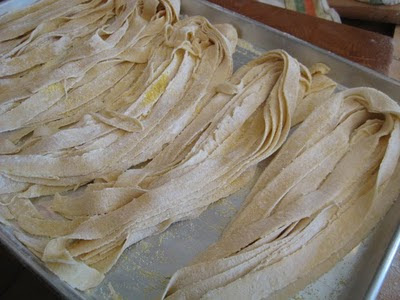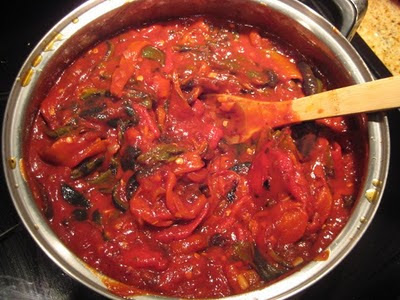Italian Food by Any Other Name Would Taste as Good

Fig.1. Cavolo nero is very popular in Tuscany. I bought these local, leafy greens at the Jean-Talon Market.
It seems to me that there’s a problem with Italian (restaurant) food in Montreal. If restaurant offerings are indicative of anything it’s that Italian food consists primarily of calamari, pasta with some sort of meaty rosée sauce, and a grilled veal chop. Having dinner last week with a very accomplished food writer, the question came up as to why Italian restaurant food suffers in Montreal. Why do dishes such as tortellini Cardinale and fettuccini Gigi appear to be the standard in this food-centric city? While Montreal appears to push the culinary envelope when French bistros are concerned, Italian food flows in a complacent stream of over-laden ravioli Bolognese and insalata Caprese. (for some reason, the insalata Caprese appears on menus all year long.) The answer to this problem is as simple as it is complex: follow the philosophy and not the standard. It's not the dish itself that makes food Italian, but, rather, how it's made. The Italian (and French) philosophy which promotes proper ingredients above all other things; imagine if you will a piece of pancetta, butchered and cured from a local farmer, crisped to perfection, topped with a sunny-side up egg blessed with a rich, orange yolk, which can only come from a chicken who's allowed to roam free to consume insects and worms, topped with fresh, morning-pulled mozzarella di bufala, basil from your garden, and served over a thick piece of wood oven baked bread made from whole, home grown flour which has been milled at the local mill, and finally dosed in domestic olive oil. This very bruschetta I described was a breakfast I ate on a recent trip to Italy—I think about it often. Can the same bruschetta be made here in Montreal? Maybe, if you raised your own pigs, chickens, made your own cheese and baked your own bread. But as city dwellers we neither have time nor the square footage involved in caring for livestock. And just to level the playing field, people who live in the big cities of Italy are pressed for time as well, the difference is that as consumers, Italians demand that their food, and their ingredients, be made a certain way. And while the above-mentioned bruschetta might be somewhat difficult to duplicate in Montreal at the moment, we could, for instance, embrace the season, as well as our environment, and make a bruschetta using our homegrown ingredients: A French baguette smeared with a local goat cheese, (which Quebec is famous for) replace the pancetta with a seared Brome duck breast, and top it with some local arugula and caramelized apples, with great results.
It might seem too much to ask some to shop at a farmer’s market, only eat what’s in season and freeze and preserve when in season, but, if you're lucky enough to go to Italy (or France) and find yourself wondering why the food is so dam good remember that, in Italy, the focus is on proper ingredients and not the finished plate: if we forgo the labels, then a new philosophy and mindset can take place, one in which Quebec grown rapini and cavolo nero can replace the Andy-Boy variety on sale at Maxi this week. Ultimately, the choice is ours to make.
 Fig.2. I served the cavolo nero with some seared dover sole topped with a white wine and butter pan sauce (I also added some sliced, preserved, Morrocan lemons to my sauce.) The greens will work with any type of meat or pasta. In Tuscany they make big pots of ribolita soup with cavolo nero as one of the main ingredients.
Fig.2. I served the cavolo nero with some seared dover sole topped with a white wine and butter pan sauce (I also added some sliced, preserved, Morrocan lemons to my sauce.) The greens will work with any type of meat or pasta. In Tuscany they make big pots of ribolita soup with cavolo nero as one of the main ingredients.
Grilled Fish with Garlic Cavolo NeroServes 4 to 5
I bought the cavolo nero at the Birri kiosk located in the Jean-Talon Market. Unlike rapini, Swiss chard or spinach, cavolo nero does not wilt, it retains its shape very well. It has a taste and texture similar to cabbage and is quite sweet. Sometime called black-leaf kale in English, cavolo nero is very filling and very low in calories. I’m happy to report that more and more farmers are growing leafy greens here in Quebec. I like to freeze leafy greens, especially when they’re in season as they are now. Simply blanch the greens in boiling water, drain, and store into freezer bags, removing as much air from the bag as you can. When the weather gets cold, you’ll be able to make a thick, Tuscan ribolita soup with all of the cavolo nero and Swiss chard sitting in your freezer.
To cook the cavolo neroIngredients:4 tbsp extra-virgin olive oil
4 cloves fresh garlic, chopped
2 bunches of cavolo nero, (you can leave the cavolo whole or you can chop it, your choice) washed, ends removed.
red pepper flakes
salt and pepper
 Fig.3. Warning: cavolo nero does not wilt and has the uncanny ability to retain its original form no matter how long you cook it, so use a big pan or cook the greens in instalments. More warnings: the greens will clean out your inner tubes so keeping a close proximity to a bathroom is essential.
Fig.3. Warning: cavolo nero does not wilt and has the uncanny ability to retain its original form no matter how long you cook it, so use a big pan or cook the greens in instalments. More warnings: the greens will clean out your inner tubes so keeping a close proximity to a bathroom is essential.
Directions:
Blanch the cavolo nero in a big pot of boiling water for 5 minutes. In a pan, heat the oil over medium heat and lightly brown the garlic. Remove the garlic from the pan and set aside. Drain the cavolo nero well and add to the pan, (you might have to add more olive oil to your pan) cook for 5 to 6 minutes. Add the pepper flakes, salt and pepper, add the cooked garlic you set aside, and serve with your fish—or chicken, or steak, or sausage, or beans, or pasta; you get the idea.
Note: If you can’t find cavolo nero use rapini or Swiss chard, just try and make it local.
 Fig.1. Chef Dany Patry of Charcuterie Noël shows off his cipaille Gaspesien.
Fig.1. Chef Dany Patry of Charcuterie Noël shows off his cipaille Gaspesien. Fig.2. Chicken pies before.
Fig.2. Chicken pies before. Fig.3. Chicken pies after. These are individual sizes but they're big enough for two.
Fig.3. Chicken pies after. These are individual sizes but they're big enough for two. Fig.4. Tortiere. Noel offers both large pies and individual.
Fig.4. Tortiere. Noel offers both large pies and individual. Fig.5. Tortiere de sanglier, topped with a homemade tomato chow chow.
Fig.5. Tortiere de sanglier, topped with a homemade tomato chow chow. Fig.6. French onion soup on the simmer. Patry lets it reduce which concentrates the flavor. What you don't see sitting at the bottom of the broth are several pork bones.
Fig.6. French onion soup on the simmer. Patry lets it reduce which concentrates the flavor. What you don't see sitting at the bottom of the broth are several pork bones. Fig.7. French onion soup and coquille St-Jacques. Vacuumed sealed and ready to pop in the oven.
Fig.7. French onion soup and coquille St-Jacques. Vacuumed sealed and ready to pop in the oven.









































